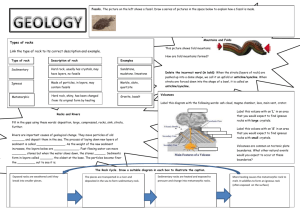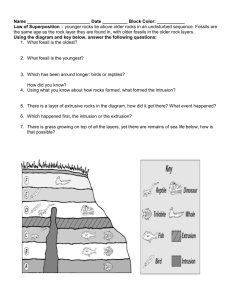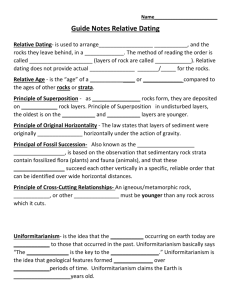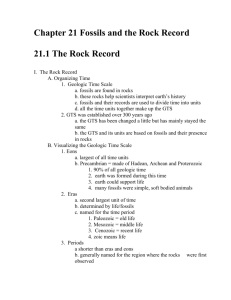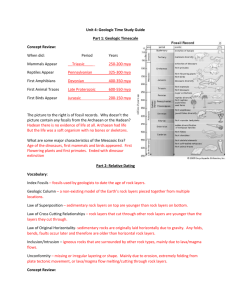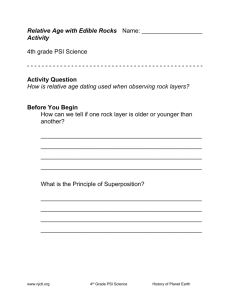Quarter 1 Common Assessment Study Guide Answer Key
advertisement
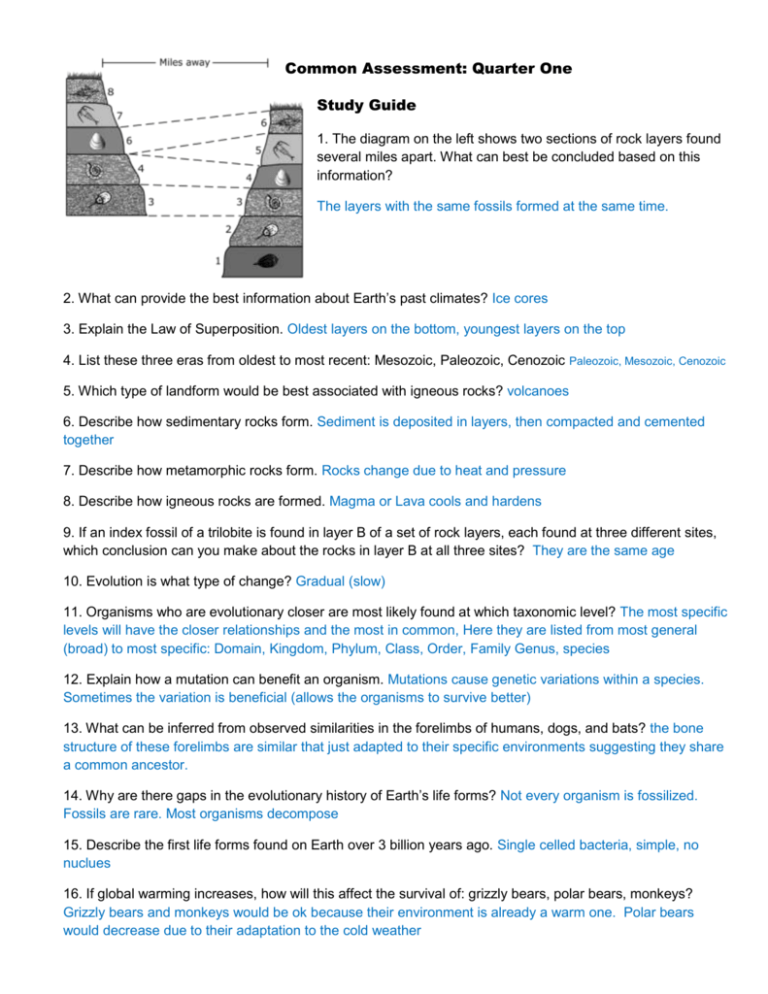
Common Assessment: Quarter One Study Guide 1. The diagram on the left shows two sections of rock layers found several miles apart. What can best be concluded based on this information? The layers with the same fossils formed at the same time. 2. What can provide the best information about Earth’s past climates? Ice cores 3. Explain the Law of Superposition. Oldest layers on the bottom, youngest layers on the top 4. List these three eras from oldest to most recent: Mesozoic, Paleozoic, Cenozoic Paleozoic, Mesozoic, Cenozoic 5. Which type of landform would be best associated with igneous rocks? volcanoes 6. Describe how sedimentary rocks form. Sediment is deposited in layers, then compacted and cemented together 7. Describe how metamorphic rocks form. Rocks change due to heat and pressure 8. Describe how igneous rocks are formed. Magma or Lava cools and hardens 9. If an index fossil of a trilobite is found in layer B of a set of rock layers, each found at three different sites, which conclusion can you make about the rocks in layer B at all three sites? They are the same age 10. Evolution is what type of change? Gradual (slow) 11. Organisms who are evolutionary closer are most likely found at which taxonomic level? The most specific levels will have the closer relationships and the most in common, Here they are listed from most general (broad) to most specific: Domain, Kingdom, Phylum, Class, Order, Family Genus, species 12. Explain how a mutation can benefit an organism. Mutations cause genetic variations within a species. Sometimes the variation is beneficial (allows the organisms to survive better) 13. What can be inferred from observed similarities in the forelimbs of humans, dogs, and bats? the bone structure of these forelimbs are similar that just adapted to their specific environments suggesting they share a common ancestor. 14. Why are there gaps in the evolutionary history of Earth’s life forms? Not every organism is fossilized. Fossils are rare. Most organisms decompose 15. Describe the first life forms found on Earth over 3 billion years ago. Single celled bacteria, simple, no nuclues 16. If global warming increases, how will this affect the survival of: grizzly bears, polar bears, monkeys? Grizzly bears and monkeys would be ok because their environment is already a warm one. Polar bears would decrease due to their adaptation to the cold weather 17. Explain the four main points of Natural Selection. Overproduction: a species always produce more offspring that can survive Variation: within a species there is a variety of traits due to random mutations Adaptation: some variations are beneficial Selection: the individuals with the beneficial variations are more likely to survive and reproduce passing that variation to the offspring 18. What was the difference between Lamarck and Darwin’s theories of Evolution? Lamacrk though acquired traits could be passed to offspring, Darwin said that only inherited traits could be passed to offspring. 19. How does natural selection drive evolution? Natural selection causes Evolution or the slow change in species over time. 20. What is the relative age of an igneous rock intrusion between two layers of sedimentary rock? Intrusion are always younger than the rock they cut through 21. What type of rock is an index fossil most likely found in? sedimentary rock 22. What type of structures are the wings of birds and butterflies? analogous 23. Explain evolution. Change of a species over time 24. What is a vestigial structure/organ? Structures that are no longer useful to an organism suggesting that the species has evolved (changed over time) 25. What is a homologous structure? Body parts with similar structure but different functions. 26. What is an analogous structure? Body parts with different structures but the same fuctions 27. A cat’s scientific name is Felix domesticus, which genus does it belong to? Which species? Genus is Felix and species is domesticus 28. List the eight levels of classification, in order. Domain, Kingdom, phylum, Class, order , family, genus ,species 29. What is the broadest level of classification? domian 30. Name the characteristics of archaebacteria. Prokaryotic, single celled, live in extreme environments. 31. Which of the geologic time eras was dominated by reptiles? mesozoic 32. Where is evidence most often found to represent a record of Earth’s history? Fossils, rock layers, ice cores 33. How have scientists determined the Earth is about 4.5 billion years old? Radioactive dating igneous rocks, specifically using Uranium 34. Explain relative and absolute dating. Relative dating is dating a rock or fossil compared to another rock or fossil, absolute dating is getting an exact age 35. Explain what an adaptation is. A beneficial genetic mutation 36. Explain how variations in a population are created. Genetic mutations (random mistakes in the DNA) 37. Describe organisms from each of the six kingdoms of life. 38. How does carbon-14 dating work? Carbon-14 is used to radioactively date once living material such as bones or shells. 39. Why are index fossils useful to scientists? They help date other rocks and fossils 40. Explain how natural selection works, using a grassland environment with green and yellow beetles as an example. Green beetle will be less likely to be eaten as they blend into the green grass. Over time, only green beetles are born and the population changes Good Luck!



